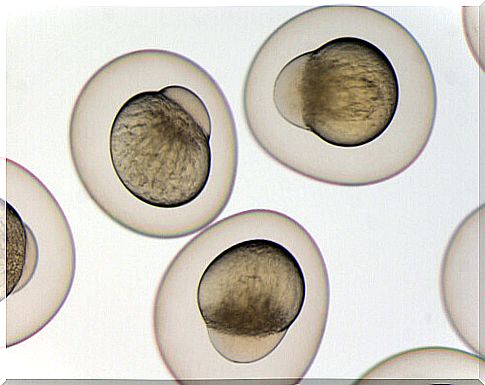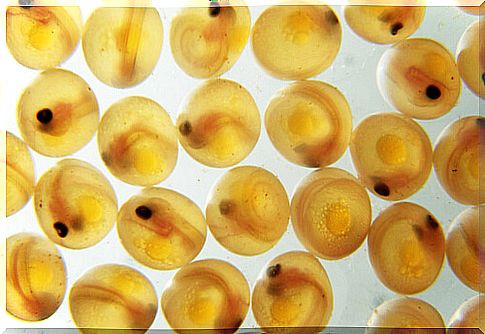Stages Of Embryonic Development Of Fish

There is no doubt that the embryonic development of fish is as fabulous as that of any other animal. The processes that take place to form a new life are fascinating. In this article we will tell you how a fish is formed. It’s really interesting!
Embryonic development: general concepts
Before talking about embryonic development of fish, it would be good to learn a little about embryology in general.
To begin with, there are different types of eggs, depending on the organization of the yolk inside. They can be isolecytes (as in mammals), centrolecytes (arthropods), and telolecytes (mollusks, fish, reptiles, birds, or amphibians). In any case, there are three phases within embryonic development, which are the following:
1. Segmentation
Cell divisions occur and end in a state called a blastula.
2. Gastrulation
Cells reorganize and give rise to blastoderms.
3. Differentiation and organogenesis
The tissues and organs are formed, which fix the structure of the new individual to develop.
In addition, we cannot ignore what happens with temperature, which is fundamental in the embryonic development of fish, but also of other animal species. Eggs are more likely to finish their cycle – that is, hatchlings – if the ambient temperature does not vary by more than 8 ° C.
When this does not happen and they go through extreme temperatures, there is less chance that they will hatch and more likely that the young will be born with serious abnormalities or will not survive the first hours.

How is the embryonic development of fish?
Now that we know the basic notions of embryology, we will briefly explain what are the different stages that a fish embryo goes through inside a telolecito egg before being born:
1. Zygotic phase
Once the egg is fertilized by the male, it remains in a zygote state until the first division occurs. How long does this process take? Everything will depend on the species and the temperature of the waters. For example, zebrafish need 40 minutes to perform the first segmentation after fertilization.
2. Segmentation phase
It begins when the first division of the zygote occurs and is a meroblastic segmentation. This happens because the eggs of the fish have a yolk that limits the area where the embryo can develop. Therefore, it has a reduced space in which to segment.
3. Gastrulation phase
In this third phase , cells are rearranged through morphogenetic movements (so that they all have the same information). In the embryonic development of fish this stage is known as involution.
This phase is characterized by a reduction in the rate of cell division and no growth. Likewise, many interesting things do happen, since for example the endoderm, the ectoderm and the discogastrula are formed, all cell layers.

4. Differentiation phase
Now is the time for specific organs to appear that allow the new individual to be identified. For example, in this stage of differentiation, the cephalic (brain), optic (eyes) and blastopore (anus) vesicles appear.
Little by little, the bones of the spine, muscles and other organs will also be formed: epidermis, dermis, nervous system, digestive tract, reproductive organs, circulatory system, etc.
Once the individual is perfectly formed, it is the moment of hatching, the final stage of embryonic development in fish. When these are born, they already have the same shape as when they are adults, but in a small size. As if they were an exact copy of their parents!









